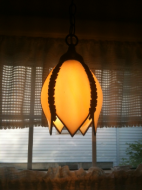I just picked up a few of those lollipop-shaped Phillips LED "bulbs" from Home Depot. On sale for $3 and change.
 Our experiences with LED light bulb replacements
Our experiences with LED light bulb replacementsI have one in the ceiling light over the kitchen sink. It looks nice and doesn't seem to throw any heat.
 Our experiences with LED light bulb replacements
Our experiences with LED light bulb replacementsDon't know what the base is doing temp-wise. If I ever get my IR thermometer back I'll have to check it. The CFL lamp that was in there has a discolored base from the heat its ballast generated.
Also found this shot of the inside of one of these bulbs.
 Our experiences with LED light bulb replacements
Our experiences with LED light bulb replacementsWhich is great because I was very tempted to crack one open just to see what was inside. $3 saved!

I can't help thinking a time will come when we'll need to liberate these lamps from AC because the inefficiencies of converting 110v down to what the LEDs need is a waste. I have seen some vacation-type homes wired for regular AC (required by building code)
and low-voltage DC for things powered by the solar panels on the roof. I think as time goes on we'll see more of this. Possibly with the electrical mains remaining the way they are - but with only a small number of outlets to provide 110v or 220v AC to less efficient devices like clothes dryers, convection and microwave ovens, air conditioners, etc. The rest of the outlets, that power everything else, will be low-voltage DC driven by a single transformer/regulator located in the basement.

---------------
Update: it's been in for a few hours now and it's warm. If I put my fingers on the ring around the 4 o'clock mark, I can keep them there about 3 seconds before I have to move them. It's definitely hot enough to burn.
Oh well! So much for the heat reduction. The CFLs are definitely running cooler. The lamp base is equally hot - but at least the CFL tube was touchable. Not so the LED ring.

